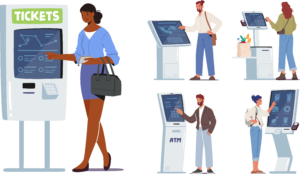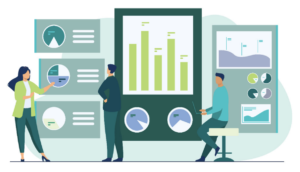Turning Patient Touch Points into Revenue Opportunities
By Chloe from Clearwave | March 14, 2023
How are high-growth practices preparing to thrive even in the face of economic uncertainty?
To weather ongoing economic challenges, along with staffing and medical supplies costs – practices are leaning into digital solutions to enable faster time to revenue and improve overall efficiency. In this landscape, it’s more important than ever that healthcare practices put strategies in place to capture revenue at every touchpoint throughout the patient’s journey. Here are a few key areas to focus on.
Capturing Revenue: Pre-Visit Patient Touchpoints
In the pre-visit phase, it’s all about patient acquisition – and today, a strong digital experience is essential for winning new patients. People of all ages – no longer just millennials – now rely on the internet to get things done quickly, easily and on their own time.
Offering digital self-service appointment scheduling can be a huge draw for potential patients (and existing ones, too). According to KPMG’s “Healthcare 2030: The consumer at the center” report, “58% of millennials and 64% of Gen Xers value online booking to the extent that they would switch providers in order to do so.”

Digital self-service scheduling provides many benefits for both patients and providers, including:
- Easy scheduling: With digital self-service scheduling, patients can book appointments when it’s convenient for them. Gone are the days when patients are pigeonholed into having to call a provider during office hours when they are most likely busy themselves. High-growth practices offer their patients the flexibility to schedule their own appointment after hours or on the weekend. In fact, research shows that 40% of appointments are booked after business hours – translating into a major missed opportunity for practices lacking online self-service scheduling. From a provider’s perspective, digital scheduling can be a competitive differentiator and a major factor in patient acquisition and retention.
- Waitlist options: Many practices that offer self-service scheduling are adding a waitlist feature to their system, to minimize appointment gaps and revenue losses. While a waitlist can’t help practices avoid no-shows, it can help them increase patient throughput to reduce the impact of missed appointments on their bottom line. For patients, a waitlist gives them the flexibility to become NextUp for a time slot that works best for them – and often, they’re able to get in to see their provider much sooner than anticipated.
- Same-day visits: Research reveals 26% of online appointments are for same-day or next-day visits. Digital self-service scheduling allows canceled appointments to be re-released back into inventory for patients who need an urgent or same-day visit. A real-time online scheduling tool not only improves patient convenience but also optimizes providers’ schedules to efficiently fill all available time slots – increasing realized revenue.
The common theme throughout all online self-scheduling options is that they make the healthcare experience modern and seamless for patients while infusing revenue back into the practice. Online scheduling and waitlist options are a key first touchpoint you can use to drive patient acquisition and retention and ensure providers’ schedules are full all day, every day.
Patient Acquisition in Action:
“The real benefit is ultimately: This online scheduler never sleeps, it never takes breaks, it never goes on lunch, it never gets sick – it’s always there.” – Ben Seals, CEO of Thomas Eye Group .
Learn more about their story in this conversation on accelerating patient acquisition.
Capturing Revenue: In-Office Patient Touchpoints
Point-of-service collections and in-office patient experiences will significantly impact your practice’s growth potential. Unlock hidden revenue potential at check-in while creating an experience your customers require — one that drops wait times and accelerates collections.

Research reveals that 49% of patients want the ability to check in or complete health forms before arriving. Investing in a patient revenue platform™ can benefits patient and practice by:
- Reducing wait times: Asking patients to come in for their appointment at least 10 minutes early to fill out a packet of paperwork forces them to take even more time out of their busy day and sit in the waiting room longer than needed. In fact, 2 out of every 5 patients are frustrated with their doctor before their visit, due to long in-office wait times. Digital patient-led registration overcomes these challenges by allowing patients to pre-register for their visit in advance, from the comfort of their own home, using their own phone, tablet or computer. With pre-registration completed at home, the digital check-in process can be fast and easy. Additionally, patients can avoid waiting in lines at the front desk by using in-office mobile, tablet or kiosk check-in solutions.
- Providing a seamless registration process for all patients: For the patients who prefer to complete intake in the office, you can also use patient-led registration tools, like a kiosk, mobile QR code, or tablet, to enable them to quickly complete intake and pay their co-pays and past due balances. Patient-led registration tools lead to significant drops in wait times and allow your staff to reallocate their time to other administrative responsibilities, versus checking in patients.
- Increasing collections: With patient-led registration tools like in-office kiosks or mobile pre-registration links, patients can be prompted to pay their deductibles, outstanding balances and even care estimates. When patients are prompted to pay through these tools, you can help your staff avoid awkward interactions, like asking for past-due balances. Additionally, you can ensure each patient is prompted to pay their co-pay, without relying on your staff who may forget to ask. Practices using digital registration tools tend to see significant revenue gains from a surge in point-of-service collections.
In order to drive revenue and improve efficiency through patient self-registration, ensure your digital tools are passwordless and portal-free, so your patients can easily complete registration and make their payments prior to receiving care. From a business standpoint, digital patient-led registration can support cash flow by ensuring providers’ daily schedules stay on track and patients pay their responsibility due at check-in.
Revenue Results in Action:
“Since implementing Clearwave, we’ve seen an incredible return on our investment. Patients have effortlessly adapted to using kiosks. Our rejected claims have dropped by approximately 20%. Our point-of-service collections at the kiosk have increased by roughly 78%.” – Jason Biddy, CEO of Urology Centers of Alabama
Capturing Revenue: Post-Visit Patient Touchpoints
Practices face a number of issues that can cause revenue leakage, including unpaid and rejected claims. Additionally, with the probability of collecting payment dropping significantly once a patient leaves the office, many healthcare practices are adjusting their revenue cycle approach. Practice are implementing digital solutions to improve data capture in a way that supports follow-up for collections and claims processing.

High-growth practices use modernized collection processes to improve revenue streams, including:
- Automated eligibility verification: Conducting real-time eligibility verification helps practices identify patient coverage and payment information faster. It also flags potential issues at the time of scheduling or check-in and improves clean claim submissions. With this functionality, front-office staff can be freed from time-consuming and tedious follow-up with insurance payers and practices can minimize the number of unpaid and rejected claims to protect themselves against coverage shortfalls.
- Care estimates: On average, 58% of self-pay patients end up as a write-off. But this doesn’t have to be the case. One of the most effective ways to improve time-to-revenue and reduce non-payments, receivables and penalties associated with claim resubmissions is to leverage automated revenue solutions that will help determine financial responsibilities and verify what services can be paid for prior to providing care. Automated tools can help track patient deductibles, out-of-pocket expenses and other financial information. With this information calculated and tracked you can provide patients with more accurate estimates, minimizing unnecessary financial surprises after an appointment that could lead to non-payment.
Implementing digital tools that automate manual verification and collections processes can reduce post-visit billing hassles for staff while helping practices strengthen their financial health.
Practice Growth in Action:
“Going beyond our goal of driving compliance, our patient responsibility due, like most practices, was high. This estimations approach is helping us tackle that challenge and increase self-pay collections.” – Jennifer White, CEO of Concord Orthopedics
Improving and Growing Practice Revenue Steams
High-growth practices are bracing for the potential impacts of rising costs and a tumultuous economy by investing in automated patient revenue solutions that create new revenue streams, increase cash flow and fuel growth.
Clearwave Core is purpose-built for high-growth practices, helping them modernize the patient journey, accelerate acquisition and reduce profit leakage. See how practices are using Clearwave Core to unlock hidden revenue potential.
Recommended for you
Related Posts
Calculate How Medical Insurance Verification Software Saves 500+ Staff Hours
Reading Time: 3 minutesBy Blakely Roth | April 16, 2025 Stretched thin in the billing or administrative department and looking for a way…
How FQHCs Improve Revenue Management With Patient Kiosks
Reading Time: 3 minutesBy Blakely Roth | April 9, 2025 East Jordan Family Health Center (EJFHC) is a Federally Qualified Health Center (FQHC)…
Patient Self-Scheduling Adoption Reaches New Heights at 87%
Reading Time: 3 minutesBeyond Utilization, Clearwave Data Unveils Features That Increase Patient Acquisition by 174% and Save 1,500 Staff Hours ATLANTA, April 2, 2025…




